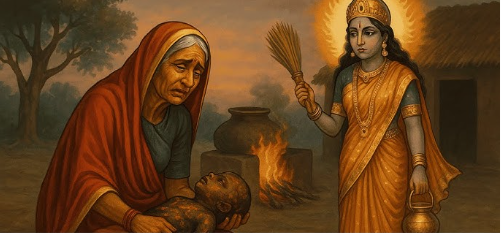Randhan Chhath Puja 2025: History, Significance & How to Celebrate It Right
- Sonali Singh
- Aug 14
- 3 min read
Randhan Chhath, on a soft August morning before Sheetala Satam, is a sacred Gujarati ritual honoring family, tradition, and ancient spirituality through cooking and offering.
Certain mornings of August carry a special kind of softness. The air smells fresh from the rain. Rooftops drip with water. In many Gujarati homes, the kitchen stove is busier than usual. This special day is called Randhan Chhath. It is celebrated a day before Sheetala Satam. Sheetala Satam is a festival dedicated to Sheetala Mata. She is the goddess who protects families from illness and keeps homes healthy. On Sheetala Satam, no cooking happens, and kitchens remain calm and cool. Hence, Randhan Chhath is the day when all cooking is done with devotion for the next day’s offerings.

The Sacred History of Randhan Chhath
Randhan Chhath is traditionally observed on the sixth day (Shashthi) of Krishna Paksha in the month of Shravan. It is intricately linked to Lord Balram, the elder brother of Shri Krishna. In many traditions, this day is celebrated as Balarama's birthday, known as Balarama Jayanti or Hal Chhath, with great devotion.
Balram, known as the deity of agriculture and strength, is worshipped for food security, prosperity, and family health. His plough (hala) stands for nourishment and support. It is the foundation of life. On this day, women fast and pray. They ask for their children’s long life and happiness. They also seek blessings from Sheetala Mata. She is the cooling goddess of health and cleanliness.
This day brings alive the eternal teachings of Sanatangyan—reminding us that divine life begins at home, with sadhu bhavana (pure intention), shauch (cleanliness), and seva (selfless service).

Different Names, Same Devotion
Across India, this sacred day takes different forms but shares the same soul. Known as Hal Chhath, Harchhath, Pinni Chhath, Chandan Chhath, and Lalahi Chhath in various regions, the ritual honours not only the kitchen but also the tools of labor. Farmer families clean and honor their ploughs and sickles. Other people focus on cooking special dishes. These include kheer, puri, and pitha. They prepare these in a clean kitchen.

Shubh Muhurats for Randhan Chhath 2025
In 2025, Randhan Chhath falls on August 14, a Thursday. The Shashthi Tithi begins at 4:23 am on August 14 and ends at 2:07 am on August 15. Here are the best times for your cooking and puja:
Amrit Kaal: 6:50 am – 8:20 am
Abhijit Muhurta: 11:59 am – 12:52 pm
Vijay Muhurta: 2:37 pm – 3:30 pm
Ravi Yoga: 9:06 am (Aug 14) – 5:50 am (Aug 15)
Sarvartha Siddhi Yoga: Entire day
According to the Sanatangyan understanding of muhurta, food cooked in these windows is more than just edible—it is prasad, blessed by time and intention.
How to Celebrate Randhan Chhath: Step-by-Step Ritual Guide
1. Morning Bath and Vow
Start the day before sunrise by taking a full bath. Wear clean and bright clothes. Make a quiet promise to fast and cook your meals with care and devotion.
2. Kitchen Cleansing
Clean the kitchen well by sweeping and washing it. Traditionally people spread a thin layer of cow dung mixed with water on the floor. This is an old practice from sanātan tradition to keep the kitchen clean and pure.
3. Setting the Altar
Set up a small altar near the kitchen. Place images or idols of Lord Balram and Sheetala Mata. Offer belpatra leaves, durva grass, turmeric, kumkum, and grains. These are given as prasad.
4. Cooking with Purity
Use earthenware, brass, or wooden utensils if possible. Prepare satvik foods—no onions, garlic, or meat. Common dishes include puri, dal-chawal, kheer, and pitha. Maintain calmness and avoid quarrels, as food absorbs the cook’s energy.

5. Covering and Storing Food
Once the food is cooked, let it cool down. After that, cover it with a clean cloth. Store it safely for the next day’s offerings.
6. Evening Devotion
Do a small puja and offer some of the cooked food to the gods. Thank them and ask for their blessings.
What to Avoid on Randhan Chhath
Do not eat the food cooked on Randhan Chhath until the next day.
Avoid cooking without bathing or in an unclean kitchen.
Never use leftovers or impure ingredients.
Maintain a peaceful and sacred atmosphere.
Blessings and Significance
Those who observe Randhan Chhath with devotion seek:
Long life and good health for children.
Protection from illnesses by Sheetala Mata’s grace.
Prosperity and food security at home.
Peace and harmony in the household.

Randhan Chhath reflects how the sanātan tradition harmonizes faith and hygiene. Historically, resting the kitchen ensured cleanliness before modern refrigeration.
Randhan Chhath Puja brings together devotion, tradition, and cleanliness. It honors family health and prosperity through cooking and rituals. Celebrated with care, it connects us to ancient wisdom that values both spiritual and physical well-being. It is a meaningful preparation for Sheetala Satam.

Comments